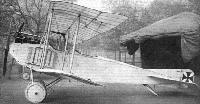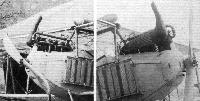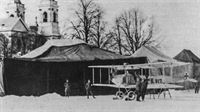В.Кондратьев Самолеты первой мировой войны
АЛЬБАТРОС B-I/B-II/B-III / ALBATROS B-I/B-II/B-III
Последним невооруженным "Альбатросом" стал B-III, разработанный в конце 1914-го инженером Шубертом. "Визитной карточкой" этого авиаконструктора являлась округлая форма стабилизаторов на всех его самолетах. B-III, прозванный за относительно небольшие размеры и характерную окраску "Блау Маус" ("голубая мышь"), также широко применялся в качестве разведчика на западном и восточном фронте.
После установки вооружения и ряда несущественных изменений в конструкции B-III переименовали в C-III. Его выпускали заводы OAW, BFW, DFW, Ханзеатиш Флюгцойгверк (HF), Сименс-Шуккерт Верк (SSW) и LVG. "Альбатрос" C-III продержался во фронтовых частях до весны 1917 года.
Данные об объемах серийного выпуска "Альбатросов" весьма приблизительны. Однако с уверенностью можно сказать, что в 1914-1915 годах построено не менее 2000 машин различных модификаций. Помимо немецких, на них летали австрийские и болгарские экипажи. Несколько экземпляров B-III продано в Швецию.
ДВИГАТЕЛЬ
B-III - "Мерседес", 160 л.с. или "Бенц", 150 л.с. или "Аргус", 180 л.с., на некоторых экземплярах C-I - австрийский мотор "Рапп", 150 л.с.
ВООРУЖЕНИЕ
Не предусмотрено.
Показать полностью
А.Александров, Г.Петров Крылатые пленники России
Последней в серии "Альбатросов" класса Б оказалась модель Б. III, созданная в том же 1914 г. Она отличалась от предшествующей немного меньшими размерами и хвостовым оперением новой конфигурации. Двигателями служили 100 и 120-сильные "Мерседесы", 120-сильные "Аргусы" и 150-сильные "Бенцы". Их выхлопные газы собирались в коллектор и выбрасывались из него под фюзеляж или над верхним крылом. Над центральным креплением верхних несущих плоскостей устанавливался обтекаемой формы расходный топливный бак, а вырез над кабинами принял округлые V-образные очертания. Являясь детищем инженера Отто Шуберта (Otto Schubert), в германских частях "Альбатрос Б. III" был прозван "голубым мышонком" (происхождение прозвища не вполне понятно); в 1915 г. "Б-третьи" активно использовались армейской и флотской авиацией противника. Пленный аппарат на снимке 35 можно считать типичным представителем данной модели, но дело несколько портит его неправильной формы вырез верхней плоскости над фюзеляжем. У другого аэроплана (36) с вырезом все в порядке, но радиаторы "Хазет" заменены радиаторами коробчатого типа - несомненно, переделка была проведена в российском отряде, так как устройства подобной конструкции имели широкое хождение в нашей авиации и служили для охлаждения двигателей мощностью 130-150 л. с.
Показать полностью
O.Thetford, P.Gray German Aircraft of the First World War (Putnam)
Albatros B III
A small number of B IIIs was built during 1915 and used for reconnaissance duty. Construction was the same as that used for B II, although tail surfaces were of the new shape that later became commonplace in the C III. Engine, 120 h.p. Mercedes D II. Span, 110m. (36 ft. 1 1/8 in.). Length, 7.8 m. (25 ft. 7 1/8 in.).
Показать полностью
J.Herris Albatros Aircraft of WWI. Vol 1: Early Two-Seaters (A Centennial Perspective on Great War Airplanes 24)
Albatros B.III
The Albatros B.III was a development of the B.II that featured different tail surfaces and somewhat more streamlined fuselage similar to those used on the Albatros C.III. Power was from a 120 hp Mercedes D.II; otherwise the B.III was similar to the B.II. By the time the B.III arrived it was clear that armed C-types were needed at the front and production of the B.III was limited. Despite no B.III aircraft being shown in the Frontbeststand inventory of front-line aircraft; some reached the front but most were apparently used as trainers.
As a trainer B.III offered no special advantages over the B.II, consequently the B.II, which was already a known quantity in widespread production, was ordered in large numbers as a trainer in preference to the B.III. However, the basic tail and fuselage design used by the B.III reappeared in the later armed Albatros C.III that was produced in large numbers by Albatros and other manufacturers under license.
The following serials are known for the B.III, but this list is not necessarily complete nor fully correct.
B.893/15 - B.947/15
B.1138/16 - B.1192/15
B.1516/16 - B.1559/15 (could probably start at 1513)
B.200/16 - B.209/16 (perhaps only 8)
Albatros B-Type Specifications
Albatros B.I Albatros B.II & B.IIa Albatros B.III
Engine 100 hp Mercedes D.I * 100-120 hp Argus, Benz, Sc Mercedes 120 hp Mercedes D.II
Span, Upper 14.48 m 12.80 m 11.0 m
Span, Lower - 11.10m -
Chord, Upper 1.80 m 1.80 m -
Chord, Lower 1.80 m 1.80 m -
Gap 1.80 m - -
Stagger - 0 -
Length 8.00 m (short fus.) 8.56 m (long fus.) 7.76 m 7.8 m
Height 3.15 m - -
Wing Dihedral - 2° (upper Si lower) -
Wing Sweepback - 0.5° -
Wing Area - 40.64 m2 -
Empty Weight 752 kg 725 kg -
Loaded Weight 1,197 kg 1,165 kg -
Maximum Speed 100 km/h 105 km/h -
Climb to 800m 10 minutes - -
Climb to 2,000m 35 minutes - -
* Other engines used: 75 hp Mercedes, 120 hp Mercedes D.II, 100 hp Benz Bz.II, 150 hp Benz Bz.III, 150 hp Rapp Rp.III, 140 hp Hiero
Показать полностью
M.Dusing German Aviation Industry in WWI. Volume 1 (A Centennial Perspective on Great War Airplanes 84)
Albatros-Werke GmbH, Berlin-Johannisthal (Alb)
Aircraft Development:
<...>
The Albatros B.IIIs had a basically similar superstructure to their predecessors, but already achieved speeds of up to 140 km/h. The engines used were 100 or 120 hp Mercedes D.I and D.II engines or 150 hp Benz Bz.III. Climbing speeds continued to decline (at full load: 800 m in 12 minutes, 2,000 m in 40 minutes).
<...>
Показать полностью
Журнал Flight
Flight, November 26, 1915.
THE CAPTURED ALBATROS RECONNAISSANCE BIPLANE.
OF the three captured German aeroplanes that have been for the last couple of weeks on view on the Horse Guards Parade the smaller of the two Albatros biplanes is, perhaps, the more interesting, seeing that it is of a later type than the larger fighting biplane of the same make. The majority of our readers will already be familiar with the general design and construction of the Albatros machines from the description given in our issue of April 4th, 1914, of the biplane flown over here by the well-known pilot Robert Thelen.
In its general arrangement the reconnaissance type, which is evidently a fairly recent model, does not differ to any great extent from the larger machine seen at Hendon last year, but numerous details have been altered and improved as a result, no doubt, of the lessons learned since then in actual warfare. One of the chief characteristics of the older machine - namely, that of building up the fuselage without the use of wire bracing - has been retained, so that it would appear that this form of construction has stood the test of time. The main framework of the Albatros fuselage consists of six longitudinals, of which the two lower ones are ash and the rest spruce. At intervals of a couple of feet these longitudinals are connected by struts and cross members, swelled out where they pass the longitudinals and abutting with their ends on small angle pieces, also of wood, the latter surrounding the two inner sides of the longitudinals. Instead of the usual wire bracing, rigidity is obtained by a covering of three-ply wood screwed to the longitudinals, a form of construction which was criticised by several experts at the time of the visit by the first Albatros, but which nevertheless seems to have stood up to the hard usage of aerial warfare in a satisfactory manner.
In the stern the body flattens out to a horizontal knife-edge, somewhat after the manner of the Morane monoplanes. In order to strengthen the body at its shallowest part, and also to furnish a rigid support for the steel tube that serves as a pivot for the rudder, a short keel-like fin made of wood runs along the bottom of the body from the stern forward to the tail skid supports. Seen from the rear this keel is shaped like a T with the angles between its vertical and horizontal members rounded off. A turtle back runs along the entire top of the body, its highest point being just front of the observer's seat.
Mounted on two stout longitudinal bearers, which are in turn supported on transverse members of ply wood, is the 128 h.p. Mercedes engine, in the general design of which no radical alterations appear to have been made. The usual Bosch hand-operated starting magneto is fitted so that, after swinging the propeller to draw a charge into the cylinders, the mechanic can get out of the way leaving the actual starting of the engine to the pilot.
As in the larger machine flown by Thelen the two seats of the reconnaissance biplane are placed in tandem, with the observer in front. To the left of the observer's seat and in the floor-boards of the body is a circular opening closed by a trap door through which evidently bombs are dropped. In front of the observer is mounted a wireless transmitter, current for which is furnished by a small generator mounted on the front right-hand chassis strut. The generator for the wireless set, instead of being driven from the engine, was driven by a small propeller, or, more correctly speaking, from a windmill shaped like a two-bladed propeller. The antenna of the wireless set takes the form of a stranded copper cable passing from the observer's cockpit through a short copper tube with a bell mouth. At its lower end this antenna is weighted with a piece of lead so as to prevent it from being blown straight back by the force of the wind. When nearing the ground the observer winds the copper cable up to prevent it catching in obstacles when making a landing.
On the dash in front of the pilot are mounted a number of instruments, including the Bosch starter, double switch for switching on the ordinary magnetoes once the engine has started on the hand-operated magneto, throttle and spark levers, petrol gauge, revolution indicator, manometer, tell-tale glass and pressure pump, clock, altimeter, and last, but by no means least, a Clift air speed indicator. The compass, instead of being mounted in front of the pilot as is usually the case, is built into the top plane in a position where it can be seen by both pilot and observer. The accompanying sketch will explain the placing. The controls are the usual ones, and consist of a wheel for the elevator and ailerons and a pivoted foot bar for the rudder. One of the reasons why some pilots prefer the single lever control, or "stick" as it is termed in aviation parlance, is that the wheel tends to interfere with the reading of the map. This difficulty has been overcome in the Albatros by placing the map-holder on the wheel itself in the manner shown in one of our sketches. Behind the pilot's seat is a large fabric bag evidently intended for despatches. In order to improve the view in a downward direction obtainable from the pilot's seat the trailing edge of the lower wing has been cut away near the body.
Petrol is carried in a main tank placed under the observers seat, and the fuel is forced by a pressure pump to the little streamline service tank mounted on top of the upper wing, whence petrol is gravity-fed to the carburettors. Filling the main tank is accomplished through a little circular door in the right-hand side of the body.
On each side of the body is mounted a radiator of a type that is very popular in Germany. It is, we believe, known over there as the Hazet radiator, and its chief claim to notice is that it is built up in sections, and that therefore by adding or taking away one or more sections any size engine or any climatic conditions can be suited. The two tubes, placed top and bottom respect ively, which connect the various sections of the radiator are parallel with the sides of the body, and each section of the radiator is therefore set at an angle of the tubes so as to bring them into the line of flight. An examination of the accompanying illustrations will show the general arrangement.
In section and general construction, the wings of the reconnaissance type biplane are similar to those of the large machine seen at Hendon last year. The span, however, is a good deal shorter, and there are only two pairs of inter-plane struts on each side instead of the three with which the older machine was fitted. We have before now referred in our columns to the practice of the Albatros firm of having three sets of wings for each fuselage, one large pair with three pairs of inter-plane struts on each side, for weight-carrying and duration flights, one pair a little shorter with two pairs of struts a side, and a small pair with only one pair of struts on each side, for using the machine as a fast single-seater scout.
The inter-plane struts are streamline steel tubes tapering towards the ends, where they fit into eyebolts going through the main spars. The method of attaching the bracing cables is identical with that employed on the older machine, and which was illustrated in our issue of April 4th, 1914. A steel shell rests on a fibre pad that is shaped to fit the curvature of the plane. Inside this shell is earned a steel ring to which are attached the turnbuckles of the bracing cables. The two main spars of the wings are placed comparatively close together, giving a rather great amount of unsupported trailing edge. A short distance behind the main rear spar is another spar, or perhaps it would be more to the point to call it a former since none of the bracing cables are attached to it, forming at its outer portion a support for the aileron hinges. The ailerons, fitted to the top plane only, are given an upward turn towards the tip so as to make their outer ends meet the air at a negative angle of incidence, an arrangement which appears to have been chosen with a view to rendering the ailerons more efficient inasmuch as the one on the high side is already having a depressing effect when in its normal position, increased immediately as soon as the aileron in question is moved upwards, while with the ordinary form the aileron has to move first up to the angle of no lift and then still further in order to meet the air at a negative angle of incidence. The method of operating the ailerons differs from that usually employed over here in that the crank levers are horizontal, working in a slot in the upper plane. The control cables pass from the drum on the column round pulleys mounted on the floor in front of the foot-bar to pulleys inside the wings and near the end of the lower plane. Hence the cable passes to the aileron, whilst the return or equalising cable runs to the aileron crank lever.
The two halves of the upper plane are attached to a cabane of steel tubes bolted with their lower ends to the upper longitudinals of the body. The main spars of the lower plane are secured to the fuselage in the manner shown in one of the accompanying sketches.
The tail planes present no novelties either aerodynamically or constructionally. There is the usual flat tail plane or stabiliser to which is hinged the divided elevator. On top of the fuselage is a triangular fin, to which is hinged the rudder. The crank levers, operating elevator and rudder are rather neatly designed having at their outer ends a concave socket into which fits the hemispherical head of the turnbuckle.
The undercarriage is of the simple "Vee" type, having streamline steel struts that fit with their upper ends into sockets on the lower longitudinals of the body. The apexes of the two "Vees" are connected by a transverse tube, and the tubular axle rests in the angle between the struts. The rubber shock absorbers are wound around the apex of the "Vees" and are protected against contact with the ground by leather guards strapped to the struts and passing underneath the shock absorbers. No radius rods are provided, but the movement of the axle is restricted by a short length of stranded cable on each side running from the front to the rear chassis strut. Pivoted on the centre of the axle is a brake similar to that with which Thelen's machine was fitted. This brake, which has a claw shaped somewhat like a plough-share is operated through a cable by a lever placed to the left of the pilot's seat. When wishing to bring the machine to a stand-still, the pilot pulls this lever towards him against the action of spring, and the claw digs into the ground checking the speed of the machine very quickly, but tearing up the ground in a comprehensive manner that would exclude the use of the brake when landing on such unmilitary grounds as parks and cricket grounds. If, however, there is no objection to doing a little ploughing, the brake is highly effective in pulling up the machine. A small tail skid sprung with rubber cord protects the tail planes when making a landing. We regret that we have been unable to obtain any figures regarding the weight and speed of the Albatros reconnaissance biplane.
Показать полностью





























